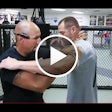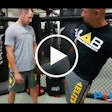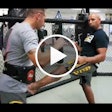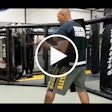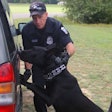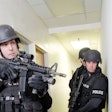Every year around a half dozen law enforcement officers die in training accidents. While some of these deaths are related to fitness and health issues---for example an officer that dies after suffering a heart attack during a training run---there are at least two or three that die as the result of firearms or other use-of-force incidents while training.
The shock and sadness following the deaths of these officers is not diminished in the least because they died in training accidents. The emptiness and grief experienced by their families and fellow officers is just as real, and the soul searching is just as intense. In fact, many times the effects of these training-related deaths are doubly tragic, especially when the weapon that fires the fatal shot is in the hands of a fellow trainee or a trainer. More than one family is destroyed in an incident like this; the officer that fires the shot will be profoundly affected for the rest of their life, and the ripples will spread to their family as well.
As trainers, we owe it to our fellow officers and their families to do everything we can to reduce the likelihood of these tragic events. Every one of us has picked up a newspaper, or has received an email notification regarding a training-related death, and has shaken his or her head, thinking, "Thank God that wasn't our department."
And we haven't even mentioned training injuries. While the instance of fatal training accidents is low, there are far more training-related injuries that occur. Some may happen through no fault of ours, but there are steps that we can take to reduce the likelihood of training injuries. When we take those steps, by reducing the potential for injuries, we also impact the probability of a training-related death.
What Can We Do?
Managing the risk of training injuries and fatalities comes down to one thing – focusing on the details. Making sure that "every 'i' is dotted and every 't' is crossed." If we take care of the little details, larger issues have a way of falling into place as well.
Start with a well thought out plan for your training. If you are undertaking force-on-force simulation training, give serious thought to what you want to accomplish. Convene a meeting of your fellow instructors and discuss the goals of your training in detail.
By the way, many trainers don't have "fellow instructors" – they are a one-person operation. If you're in that situation, think about discussing your training with trainers from surrounding departments, at one of the excellent state training officers' associations, or with fellow members of ILEETA.
Once you've clearly defined what you want to accomplish, plan your training accordingly. Decide how many people you will need in order to safely conduct the training, and what type of area you should use. Address equipment needs, and consider how much time the training will take. Decide if you will do the training in low light, and pick a time of day when interference by passers-by will be minimized.
Develop a detailed lesson plan, with your training objectives clearly outlined. Script each scenario, and each outcome for your scenarios based upon how your trainees conduct themselves. Develop evaluation forms for your trainers to use in grading trainees' performance, and think about what other documentation you'll need.
Don't forget to notify residents or other individuals in the area that you will be conducting training. And if you're going to an area where you may encounter uniformed personnel (either from outside agencies or from your own agency) make sure those officers know that you're conducting training. An uninformed citizen might call in your training as an actual crime in progress, and officers could respond with unfortunate results.
Make sure you have first-aid supplies and plenty of fluids for your trainers and trainees to drink, especially in hot weather. Consider other environmental hazards, such as wildlife, insects, traffic, and weather.
If at all possible, use trainers as actors, especially for the "bad guy" roles. The role-players acting as suspects are really the ones that control the flow of the scenario. They need to know the script, and they need to be prepared to "give up" once the officer-trainees have met the training objectives. Using other students as actors means that you won't have control over this important aspect of your training. That is both detrimental to the training mission, and it's dangerous.
Have at least one trainer that functions as a Safety Officer for each scenario. This individual should have no other responsibilities (don't assign them an acting role, etc.). The Safety Officer is responsible for making sure that only appropriate equipment is introduced into the training scenario, and then is responsible for the safe conduct of the scenario itself.
Only disabled and clearly identified weapons should be used in training scenarios, and no one should be allowed in the vicinity of your training unless he or she has been cleared for safety.
"Safety clearing" someone literally involves checking to make sure the person is not carrying any live weapons, including any firearms, knives, aerosols, impact weapons, or electronic control devices. This is the most important point: No live weapons of any type should be allowed anywhere in the vicinity of your training, unless they are specifically being used in the scenario itself, and then only once they have been checked and verified by the Safety Officer. Firearms capable of chambering and firing a live round should never be allowed in or near scenario training.
The ideal arrangement is for all of your training scenarios to take place within a larger controlled perimeter, and to have a separate Safety Officer that controls ingress and egress to the larger perimeter. This creates a redundant safety system, wherein individuals entering the training perimeter are checked for safety, and then are checked again – by a second Safety Officer – at each individual scenario.
No one should be allowed to leave the training area – even for a minute – without going through a complete safety check when they return. No one should be allowed to drop by and observe the training without going through a complete safety check. And, once training is done for the day, no one should be allowed to "try just one more quick drill" as everyone mills around. These are the specific types of occurrences which have given rise to training accidents in the past.
Someone gets a phone call, or has to run out to their car for a minute, or has to use the restroom, or goes to lunch, or…you get the idea.
This sounds like an awful lot of trouble to go through just to do some play-acting, and after all, we're all cops, and we're all professionals, and we know what we're doing. We shouldn't make a big deal out of this stuff, and besides, we don't have a lot of time to get this training done, so we need to skip some of this minor stuff and get moving. Right?
Wrong.
That is exactly the kind of thinking that has cost officers their lives in training accidents. No department thinks it will happen to them – until it does.
Stay safe, and wear your vest (and buckle up)!






